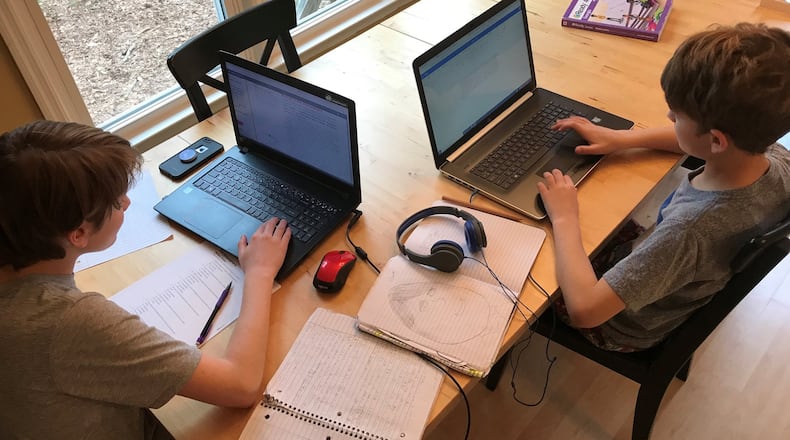Sherica Freeman said she has not connected with students in one of her American Literature classes since March 12, the day Georgia schools were told to close school buildings to curb the spread of COVID-19.
The DeKalb County School District, where Freeman works, was among the metro Atlanta school districts that decided to shift to online learning amid the shutdown. On March 13, she spent the day uploading lesson plans for her Stone Mountain High School students to use for the first two weeks of a shutdown now expected to last more than a month. So far, with at least one class, she said she’s got nothing to show for it.
“My whole fourth period doesn’t know where I am, what they’re supposed to do,” said Freeman, who has worked for the district as a teacher for 13 years. “It feels like there’s no real understanding of how these systems work … like we buy this software and never figure out how to use it.”
Many Georgia school districts opted to move learning online after a conference call March 12 with state officials around efforts to curb COVID-19’s spread. This is the longest any district has worked primarily through digital platforms, to varying levels of success. While some are seeing issues with connectivity, issues uploading class assignments and contending with the fact that not all students have devices on which to complete the online coursework, many are seeing success in how employees are banding together to see through the unexpected new normal.
While it is too soon to know how successful the transition online has been, most districts say they are moving forward from this week with the lessons learned that will make for a more smooth experience until school buildings reopen, should that happen this year.
“For having all of this happen on (March 13), we feel like this a good starting place,” said Cliff Jones, chief academic officer for Fulton County Schools.
Cherokee County has had trial runs for digital learning days, but March 16 was the first day the entire school district participated.
With four boys at home — Levi,10, Nat, 12, Luke, 14 and Elijah, 16 — Olga Spivey wondered how the dynamic would play out.
“Among the four of them, there are 25 classes a day,” she said. “But the teachers are doing things to make the experience richer and prepare the kids for a future where this is normal and expected.”
Spivey said she has loved the opportunity her children have had to see their teachers in a new light. “With the teachers working from home, the boys see that they have children who are doing school work as well. They have pets and other distractions and are making it work,” she said. “I think it’s great that they connect in a way that they haven’t before.”
Heather Nelson, an English teacher at Cherokee’s River Ridge High School, said the virtual lessons felt natural. “We’d already established a relationship with the students and knew who was self-motivated, who may need extra help and who was in-between,” she said. “By day three, I felt completely connected with everyone. The lessons are progressing pretty seamlessly.”
Miranda Satterfield, a fourth grade teacher at Little River Elementary in Cherokee County implores parents to keep a cool head.
“This is a learning curve. Parents may feel overwhelmed and teachers are teaching in a way we’ve never done before,” she said. “We’ll get through this just fine if everyone remembers that we’re all knew to this.”
A week in, Jones, of Fulton County Schools, said his district’s biggest challenge is supporting the parents who have suddenly found themselves as the primary teachers to their housebound children. The district of about 94,000 students is seeing about 35,000 of its 45,000 students with district-issued devices logging into its online learning system daily. More than 6,000 learning packets have been handed out, too.
Fulton County’s remote learning strategy includes online resources through Launchpad, where students sign in to work on class lessons left for them by their teachers. According to the district’s Remote Learning web page, schools will communicate assignments to parents and students via email and the district’s website, and assignments are due at least two weeks after returning to school. With school districts across the country now faced with the idea of finishing the school year remotely, that could change.
“We have a hotline for technical issues that has been staffed since Monday morning,” Jones said. “We’ve seen call volume double from Monday to yesterday. What it’s about is logging in and supporting the parents, supporting this new normal. We’re making sure we’re all flexible and that every day is different.”
During the school building shutdown, the DeKalb County School District uses the digital learning system Verge, with teachers uploading lesson plans that include reading assignments and assessments as well as videos and clickable worksheets. On the student interface, they are shown learning targets, what they are expected to know when a lesson is completed.
Interactive assessments will send alerts when a student gets the wrong answer, sending them to review materials to make sure students understand what they got incorrect.
Stacy Stepney, DeKalb’s chief academic officer, said teachers were to upload two weeks of lessons into the system on March 13, a scheduled planning day that just happened to coincide with the decision to shut school buildings.
“This is new space for everyone for this amount of time,” Stepney said, acknowledging this was the first time many districts had spent at least a week utilizing digital learning. “I think we are in a much better place now.”
Stepney said the district has dealt this week with some connectivity issues, trying to get an entire school district of about 99,000 students online while other school districts are logging on across the country, as well as other school systems across the globe. Monday, parents said Verge was spinning and shaky, that their children were at times unable to get assignments.
“The learning for us is this product is not just used in Georgia, or the United States,” she said, adding district officials have worked with Verge’s parent company to allow for more people to log in.
There’s also the added responsibility for remotely teaching students with disabilities who often have additional needs.
“Students with disabilities must have access to educational technology utilized by schools, and (the Office of Civil Rights) will continue to work to ensure that no student is excluded from utilizing these important tools,” said Kenneth L. Marcus, the U.S. Department of Education’s assistant secretary for civil rights.
Stepney said measures have been put in place to accommodate students, including opening schools Monday to pass out hard copies of virtual learning assignments and holding instructional phone calls to discuss and review lessons and have daily check-ins. Parents also are being encouraged to reach out to their teachers and case managers. “When this is over and normal activities resume, the teams (handling individualized education programs and special education instruction) will convene so we can look at individual student needs and next steps.”
Freeman, from Stone Mountain High School, said there was no instruction manual for when classroom instruction moves online. As a result, staffers at her school have been working collaboratively to make the transition easier, building resource pages and troubleshooting the various platforms to pass along hacks.
“The best thing I’ve seen is (instructional) coaches and department chairs, librarians … try to create order and provide resources,” she said. “They’re making (the systems) available, usable and accessible. When people are creating success, they’re sharing what they did. Just the how-tos on these things, as a lot of that was not in place.
For every lesson, Stepney said, there’s a moment for celebration. The video from a 3-year-old DeKalb Early Learning Center’s mom showing them going over the lesson plan, with him correcting her when she does not do it like his teacher. Or the video lesson from two Flat Rock Elementary School physical education teachers showing students the exercises they should perform for the week.
“Our teachers are connecting with our parents and students,” Stepney said. “From the parent answers we’ve received, we’re working to help provide a balanced learning environment. Students are also adjusting to being home all day. We want to continue supporting them socially, emotionally and academically.”
Keep Reading
The Latest
Featured




